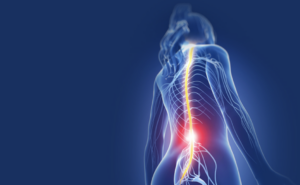LUMBAR STENOSIS

Spinal stenosis refers to the narrowing of the spaces in the spine leading to pressure or constriction of the spinal nerves in that area. Lumbar stenosis, which occurs as a type of spinal stenosis, refers to the narrowing of the spaces in the lower part of the spine. Lumbar stenosis, which occurs as the most common type of spinal stenosis, may come about as a result of degenerative changes in the spine brought about by aging. The spinal cord and spinal nerves require adequate space in the spine to allow for effective branching and when this space it’s compromised, the individual may experience severe back pain and sciatica.
Lumbar stenosis occurs commonly among older individuals due to prolonged wear and tear and may bring about symptoms such as pain and cramping in the legs, numbness, weakness, and in some severe cases, bowel or bladder incontinence.
What’s the Causes of Lumbar Stenosis?
Lumbar stenosis usually occurs due to medical conditions caused by degenerative changes in the spine brought about by aging. These conditions may include the formation of bone spurs, thickening of the spinal ligaments, and herniated discs. Other conditions that may lead to lumbar stenosis include:
- Congenital spinal stenosis; Congenital spinal stenosis refers to a condition that occurs when the spinal canal of an individual comes across as narrow from birth.
- Spinal fractures or injuries
- Tumors or cysts in the spinal cord
- Rheumatoid arthritis
- Osteoarthritis
What’s the Symptoms of Lumbar Stenosis?
Since lumbar stenosis usually occurs as a result of gradual aging, clear symptoms may not occur at the initial stage of the condition. Symptoms of lumbar stenosis may include:
- Pain and cramping in the lower back or legs that gets worse over time. This pain which occurs as a dull or sometimes burning sensation gets worse after prolonged standing or walking.
- Sciatica; Burning pain that extends from the buttocks to the legs and feet
- Numbness, tingling, and weakness in the buttocks, legs, or foot
- Loss of sensation in the feet
- Difficulty in balance and movement
- Loss of bowel or bladder control
- Loss of sexual activity
How do Spinal Specialists Diagnose Lumbar Stenosis?
Along with a detailed personal medical history, a spinal specialist will ask the patient about the symptoms experienced and the severity of the symptoms. The specialist will also carry out a physical examination to check for signs such as abnormal reflexes and loss of sensation. The specialist will recommend some imaging tests to examine the spine and make a comprehensive diagnosis. These imaging tests may include x-rays to check for bone spurs and other changes in bone structure, CT and MRI scans to provide detailed images of the spinal cord and nerves, and to check for possible spinal tumors. Other imaging tests that the spinal specialist may recommend include bone scans, myelograms, and electrical tests of muscle activity.
How do Spinal Specialists Treat Lumbar Stenosis?
Treatment options for lumbar stenosis may include physical therapy to strengthen the back and leg muscles, the use of anti-inflammatory medicines and steroid injections to relieve pain and swelling, and surgery. Surgical procedures to treat lumbar stenosis such as spinal fusion and laminectomy may only face consideration when all other non-surgical options fail to relieve pain.
References
Lumbar spinal stenosis. American Academy of Orthopaedic Surgeons. https://orthoinfo.aaos.org/en/diseases–conditions/lumbar-spinal-stenosis
Frontera WR, et al., eds. Lumbar spinal stenosis. In: Essentials of Physical Medicine and Rehabilitation: Musculoskeletal Disorders, Pain, and Rehabilitation. 4th ed. Elsevier; 2019. https://www.clinicalkey.com.
Levin K. Lumbar spinal stenosis: Treatment and prognosis. https://www.uptodate.com/contents/search.
Spinal stenosis: In depth. National Institute of Arthritis and Musculoskeletal and Skin Diseases. https://www.niams.nih.gov/health-topics/spinal-stenosis.
Ammendolia C, Stuber KJ, Rok E, Rampersaud R, Kennedy CA, Pennick V, et al. (August 2013). “Nonoperative treatment for lumbar spinal stenosis with neurogenic claudication”. The Cochrane Database of Systematic Reviews. 8 (8): CD010712.
Azar FM, et al. Degenerative disorders of the thoracic and lumbar spine. In: Campbell’s Operative Orthopaedics. 14th ed. Elsevier; 2021. https://www.clinicalkey.com.
